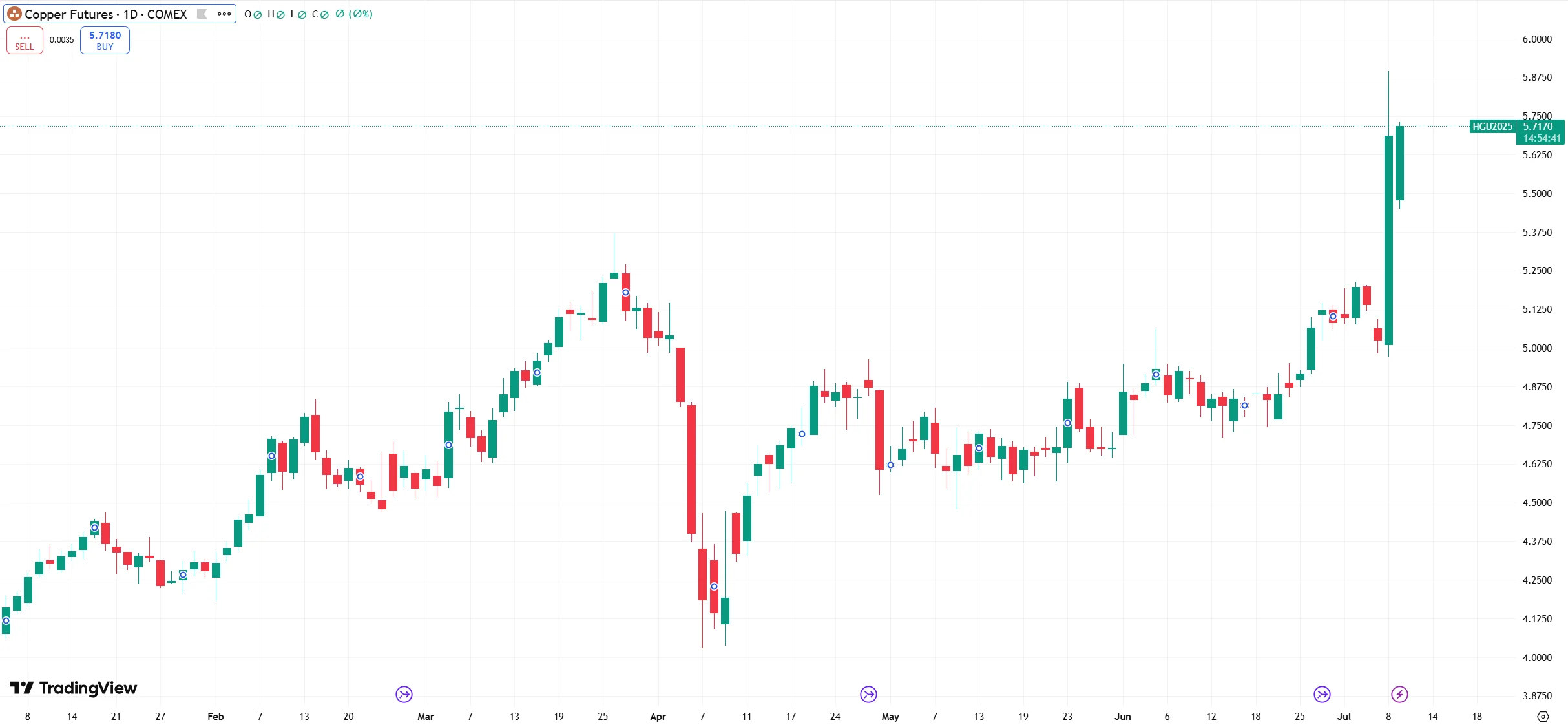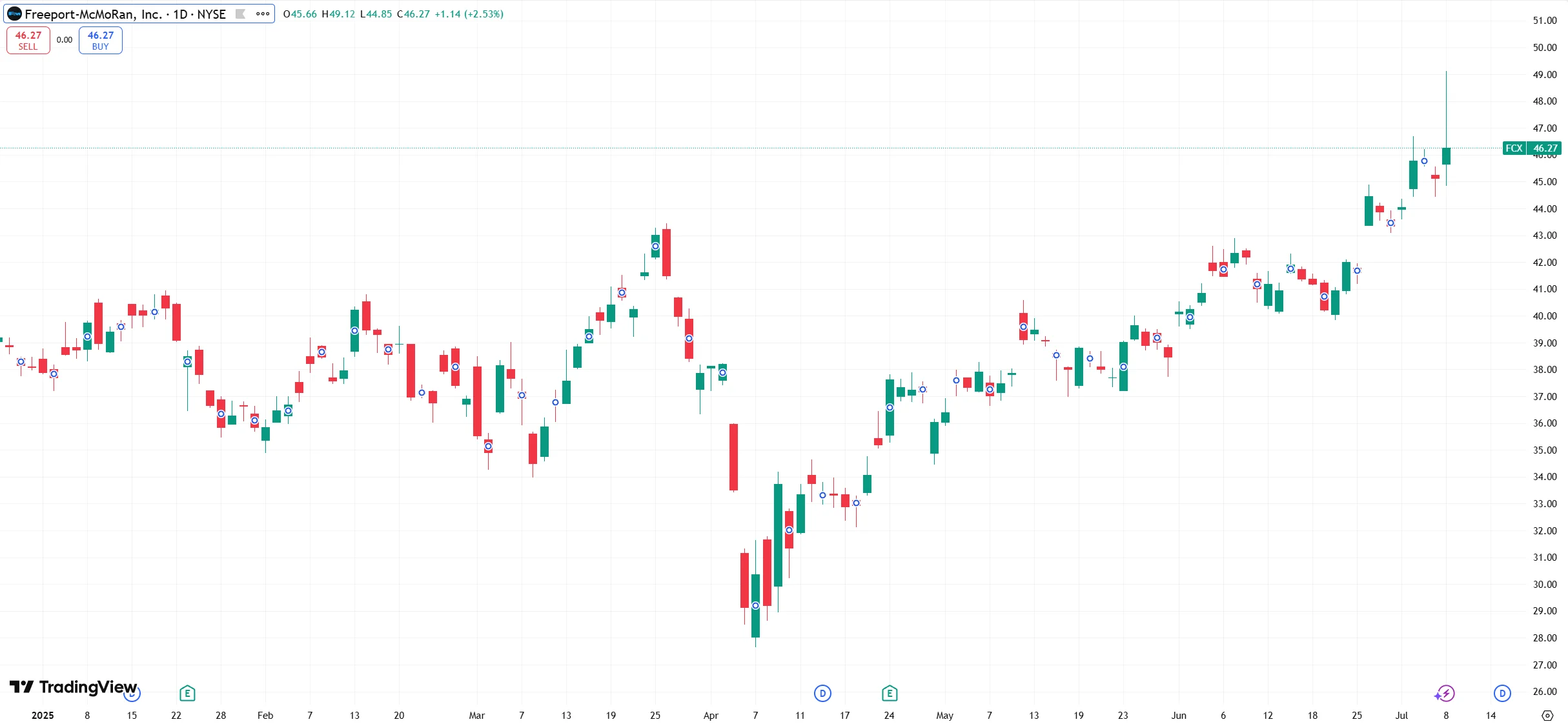U.S. Copper Tariffs to Increase to 50%, What Will This Mean for Copper Prices?
03:04 July 16, 2025 EDT
Key Points:
1. U.S. President Donald Trump has announced plans to impose a 50% tariff on imported copper, exceeding market expectations.
2. COMEX copper futures surged 17% on the same day, while LME three-month copper futures declined.
On July 8, 2025, U.S. President Trump stated during a Cabinet meeting at the White House, "I believe we will raise the copper tariff to 50%," triggering a massive 17% spike in COMEX copper futures, which hit a historic high of $5.8955 per pound, marking the largest single-day gain since 1968. On July 9, the price retraced to $5.7115 per pound.
At the same time, three-month copper futures on the LME dropped 2.4% to $9,553.50 per metric ton, causing the COMEX-LME price gap to widen to $2,750 per metric ton (a 25% premium).

Source: TradingView
In recent times, traders have been shipping large quantities of copper to the U.S. to avoid the tariff, leading to a sharp increase in COMEX inventories, while LME inventories have plummeted. This discrepancy reflects market expectations of a surge in domestic copper demand in the U.S., while other global markets face supply chain pressures. As the tariff policy is gradually implemented, the global copper market is expected to undergo significant disruptions.
Behind the Tariff Hike
The Trump administration's move to impose tariffs on copper, while the specific timing of the tariff's implementation remains unclear, has a very clear objective: to strengthen the United States' autonomy within the global copper supply chain, ensure national security, and maintain the resilience of the copper supply chain.
The core aim of the tariff appears to be encouraging domestic copper production investment and development, thus reducing reliance on foreign sources. However, due to the slow pace of upstream copper mine development in the U.S., this policy may not quickly change the structure of copper imports into the country.
JPMorgan analysts have pointed out that the 50% tariff rate exceeds market expectations, which had previously anticipated a rate closer to 25%. This discrepancy has led to significant volatility in the copper market.

In fact, the global copper industry began preparing for the potential of Trump’s copper tariffs as early as February. Many traders preemptively shipped large amounts of copper to the U.S. in an effort to get it in before the tariffs were enacted. This led to a sharp increase in copper stocks in U.S. COMEX warehouses, with inventory levels even surpassing the combined stocks in London and Shanghai. This preemptive stocking spree has further pushed up copper prices in the U.S. market, while also exacerbating the global supply-demand imbalance.
U.S. Copper Demand
The United States is one of the largest markets for copper globally, with significant demand across industries such as construction, power, electronics, and automotive. Copper, being an essential raw material, has a massive demand within these sectors. However, despite the enormous consumption of copper in the U.S., the country's domestic copper production capabilities fall far short of self-sufficiency.
According to 2024 data from the U.S. Geological Survey (USGS), domestic refined copper production is approximately 1.8 million metric tons, covering about 55% of annual consumption. Arizona alone contributes more than two-thirds of this output, primarily operated by companies like Freeport-McMoRan. However, domestic production capacity is limited, and the development of new copper mines has been slow due to environmental and regulatory restrictions. For example, a large copper mine project in Arizona has been stalled for over a decade, making it difficult to rapidly scale up production.
The remaining 45% of copper demand is met through imports. The primary sources of copper imports into the U.S. are Chile, Canada, and Mexico, with more than 90% of U.S. refined copper imports coming from these countries in 2024. Chile plays a particularly important role in this supply chain, with over 510,000 metric tons of refined copper exported to the U.S. in 2024. Codelco, Chile's state-owned copper giant, is one of the largest copper suppliers to the U.S. and has increased its share of U.S. copper exports from the typical 30% to as much as 45%.
Supply Chain Adjustments
Trump's copper tariff proposal has triggered significant reactions in the U.S. market while also drawing the attention of major global copper-producing nations. Maximo Pacheco, Chairman of Codelco, Chile's state-owned copper company, stated in an interview that the company needs to understand which copper products will be affected by the tariff. He also pointed out that the details of the tariff policy remain unclear. The Chilean government added that it has not received any formal notification of the tariff implementation and is still in communication with the U.S.
Despite the uncertainty, Chile, as one of the world's largest copper producers, has already started adjusting its supply chain to mitigate the potential impact of the tariffs. Similarly, the Mining Association of Canada warned that high tariffs on copper could harm U.S. manufacturing, particularly for businesses that rely on copper for infrastructure and product manufacturing.
The sharp rise in copper prices is not only impacting global copper supply chains but could also have broader economic consequences. Copper is widely used in construction (wires, pipes), automotive (electric vehicles), and electronics (chips). A 50% tariff would increase manufacturers' costs and squeeze profit margins. Southwire Company LLC, the largest copper importer in the U.S., warned that import restrictions will exacerbate domestic supply shortages, as U.S. production is unlikely to scale up quickly enough. The Mining Association of Canada noted that U.S. smelting capacity is insufficient to replace imports, and the supply gap could widen in the short term.
The tariff could also push inflation higher. Analysts estimate that a 10% increase in copper prices could raise the U.S. Consumer Price Index (CPI) by 0.2% within 12 months, as cost increases are passed through to infrastructure and manufacturing sectors. U.S. domestic copper prices have already risen 23% compared to 2024, adding to inflationary pressures, which could influence the Federal Reserve's monetary policy.
However, not all market participants are concerned about the copper tariffs. For some U.S.-based copper mining companies, the tariff could prove to be a boon. On July 8, shares of Freeport-McMoRan, a major U.S. copper mining company, rose by 2.53%. The stock price increase reflects investor optimism that, in the context of global copper supply tightness, domestic miners stand to benefit from the tariff policy.

Source: TradingView
Nonetheless, there is a trade-off when it comes to the overall economic impact: higher costs in downstream industries could offset the benefits to miners. Additionally, the tariffs could lead to a shift in copper supply toward China, potentially strengthening its global market dominance and pushing up LME prices in the long term.
Disclaimer: The content of this article does not constitute a recommendation or investment advice for any financial products.

Email Subscription
Subscribe to our email service to receive the latest updates
